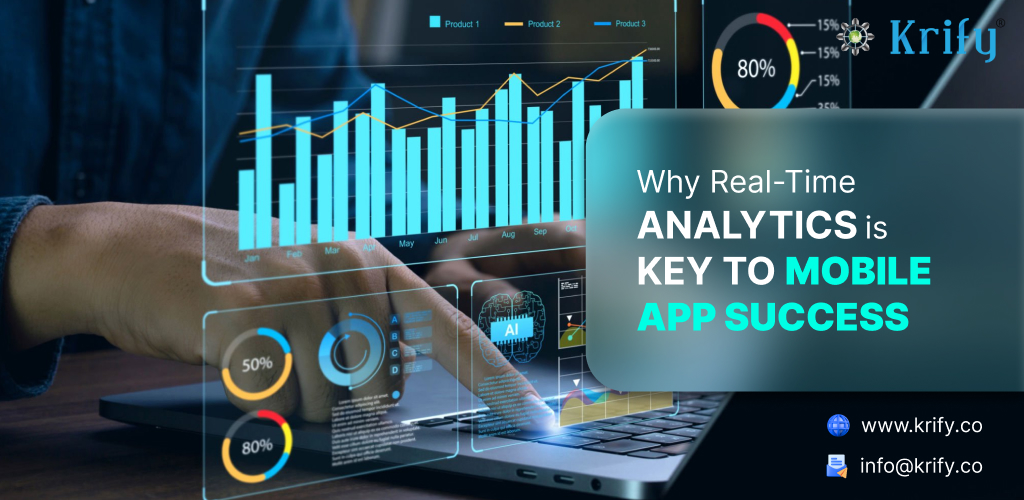In today’s competitive digital landscape, mobile apps are no longer just tools; they are essential elements that connect brands with users in dynamic ways. Delivering an exceptional user experience demands more than just innovative design and functionality. Mobile app success hinges on real-time analytics, offering immediate insights that empower businesses to make informed decisions without delay. In this blog, we will explore why real-time analytics is indispensable for mobile apps, how it optimizes performance, and how businesses can leverage it to stay ahead of the competition.
Understanding Real-Time Analytics in Mobile Apps
Real-time analytics involves collecting, processing, and analyzing data the moment it is generated. Unlike traditional analytics, which provides reports after hours or days, real-time analytics gives businesses instant access to user behavior data. This capability enables companies to identify patterns, optimize their offerings, and address issues as they arise.
1. Faster Decision-Making and Agile Adjustments
One of the primary reasons real-time analytics is critical is its ability to speed up decision-making processes. With live data, businesses can respond to trends and challenges without waiting for the end of a campaign or weekly report.
– For instance, if an app detects a sudden drop in user engagement, developers can act immediately by tweaking push notifications or altering in-app features.
– Additionally, quick responses can prevent user churn, ensuring apps retain their audience.
Transitioning from reactive strategies to proactive actions is key to staying relevant in a rapidly changing environment. As businesses shift towards data-driven models, agility becomes a core strength that fosters innovation.
2. Personalization at Scale with Real-Time Insights
User experience (UX) is at the heart of every successful mobile app. Real-time analytics empowers companies to create personalized experiences based on live interactions.
– For example, apps can recommend relevant products, show targeted ads, or send notifications that align with user preferences in real-time.
Moreover, by analyzing real-time metrics such as session duration, click patterns, and user location, businesses can ensure they deliver meaningful interactions that resonate with individual users. Seamless personalization not only boosts customer satisfaction but also increases retention rates.
3. Monitoring Performance to Avoid Downtime
Real-time analytics also plays a vital role in maintaining app performance. System errors, crashes, or bugs can drive users away if not addressed immediately. However, real-time monitoring tools enable developers to detect anomalies the moment they occur.
– If a feature starts malfunctioning or a server slows down, teams can receive alerts and deploy fixes instantly.
– Consequently, apps with real-time analytics have higher uptime and fewer negative reviews on app stores.
With transition to automated alerts and monitoring dashboards, businesses can stay one step ahead and provide uninterrupted service.
4. Enhancing Marketing Strategies and User Acquisition
Real-time analytics helps marketers track campaign performance as it unfolds, allowing them to modify strategies on the go.
– If an advertisement fails to generate expected conversions within the first few hours, businesses can quickly change ad creatives, target audiences, or budgets.
– Furthermore, real-time data supports A/B testing by highlighting which variations drive the highest engagement.
With access to immediate feedback, marketers can allocate resources efficiently and achieve higher return on investment (ROI).
5. Gaining Competitive Edge and Future Readiness
The mobile app market is highly competitive, with users expecting seamless experiences and businesses racing to exceed those expectations. Leveraging real-time analytics ensures companies can pivot in response to user needs and market shifts faster than competitors.
– When one company identifies and solves pain points immediately, it builds customer trust and loyalty that competitors may struggle to match.
– Furthermore, businesses using real-time analytics gain insights into emerging trends, helping them stay ahead of the curve.
Transitioning from static reports to live data sets businesses up for long-term success by aligning strategies with future demands.
Key Takeaways:
– Real-time analytics supports faster decision-making, personalized user experiences, and agile marketing strategies.
– Apps with real-time insights perform better, avoid downtime, and retain users more effectively.
– Businesses using live analytics tools gain a competitive edge and future-proof their strategies.
Embrace the power of real-time analytics today to ensure your mobile app thrives in the ever-evolving digital landscape!
Conclusion: Harnessing Real-Time Analytics with Krify
Mobile apps need to evolve constantly to meet user expectations and market demands. Real-time analytics acts as the foundation for this evolution, enabling businesses to respond swiftly, personalize experiences, and maintain high performance. By using real-time insights, companies stay ahead of the competition and enhance user satisfaction.
At Krify, we specialize in developing mobile apps that are future-ready, ensuring they are integrated with real-time analytics tools. Our expertise enables businesses to harness the power of live data, allowing them to make timely decisions and deliver exceptional user experiences. Partner with Krify today and unlock the full potential of your mobile app with cutting-edge analytics.
Similar Blogs
Why You Should Include Real-Time Features In Your Mobile Apps?



